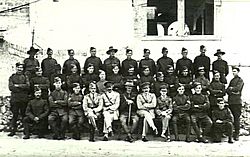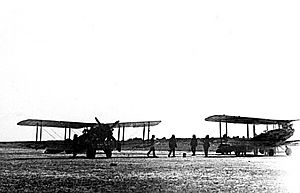No. 40 Wing RAF facts for kids
Quick facts for kids No. 40 Wing RAF |
|
|---|---|

Headquarters 40th (Army) Wing RAF, Palestine, 1918
|
|
| Active | 5 October 1917 – 1 April 1920 |
| Country | |
| Branch | British Army (before 1 April 1918) Royal Air Force (after 1 April 1918) |
| Type | Aircraft |
| Role | Counter-air Bombing Photo-reconnaissance |
| Size | 4 squadrons |
| Part of | Palestine Brigade |
| Base | Ramleh (1918) Ismailia (1919–20) |
| Engagements | Battle of Megiddo |
| Commanders | |
| Notable commanders |
Amyas Borton Richard Williams |
| Aircraft flown | |
| Bomber | Airco DH.9 Handley Page O/400 |
| Fighter | Bristol F.2 Fighter Royal Aircraft Factory S.E.5 |
No. 40 Wing was a special group of the Royal Air Force (RAF). It was part of the Palestine Brigade during World War I and for a short time after.
This wing started in October 1917 as the 40th (Army) Wing of the Royal Flying Corps (RFC). Later, in April 1918, it joined the RAF when the RFC and Royal Naval Air Service combined. No. 40 Wing played a very important role in the Battle of Megiddo in September 1918. This was the last major attack against the Ottoman Empire. The wing was officially closed down in April 1920.
History of No. 40 Wing
The 40th (Army) Wing RFC was created on October 5, 1917. It was controlled by the RFC's Palestine Brigade. Its main jobs were to fight enemy aircraft and attack enemy buildings or bases. It also did a lot of photo-reconnaissance, which means taking pictures from the air to gather information.
Another group, 5th (Corps) Wing, helped ground troops directly. The first leader of 40th Wing was Lieutenant Colonel Amyas Borton. He was followed by Alexander Shekleton in late 1917.
In June 1918, Lieutenant Colonel Richard Williams took charge. He was from the Australian Flying Corps (AFC). Under his command, the wing had No. 1 Squadron AFC and three RFC squadrons: Nos. 111, 144, and 145. No. 145 Squadron was also led by an Australian, Captain Roy Drummond.
The wing was based at Ramleh. It used Bristol F.2B and S.E.5 fighter planes. It also had DH.9 light bombers.
Role in the Battle of Megiddo
No. 40 Wing played a key part in the Battle of Megiddo. This was General Allenby's final big attack in Palestine. The wing even had a huge Handley Page bomber join its forces.
During this battle, the wing's planes caused "wholesale destruction" to Turkish groups. They did this by constantly attacking from the air. On September 21, 1918, at Wadi Fara, the Palestine Brigade, including 40th Wing's four squadrons, destroyed most of the Turkish Seventh Army. This happened as the Turkish army tried to cross the Jordan River.
This event was an early example of how much damage concentrated air attacks could do to ground troops. Williams later wrote that the Turkish Seventh Army "ceased to exist." He added that this was "entirely the result of attack from the air." A small group from No. 1 Squadron also helped Major T. E. Lawrence's Arab army. They helped when German planes attacked the Arabs north of Amman.
Historian Lawrence James said that the wing's actions during the Battle of Megiddo "assured Allenby's victory." However, this new way of fighting, causing such heavy losses from the air, shocked some people. Lieutenant General Edward Bulfin of the British XXI Corps even told Major General Geoffrey Salmond, "You are a butcher—you call that fighting?"
After the war, No. 40 Wing was based at RAF Ismailia in Egypt from 1919. It was officially closed down on April 1, 1920.
Squadrons and Aircraft
Before the Battle of Megiddo in September 1918, No. 40 Wing had these units and aircraft:
- Headquarters – Ramleh
- No. 1 Squadron AFC (used Bristol F.2B and Handley Page Type O planes)
- No. 111 Squadron RAF (used S.E.5 planes)
- No. 144 Squadron RAF (used DH.9 planes)
- No. 145 Squadron RAF (used S.E.5 planes)
See also
- List of Wings of the Royal Air Force



